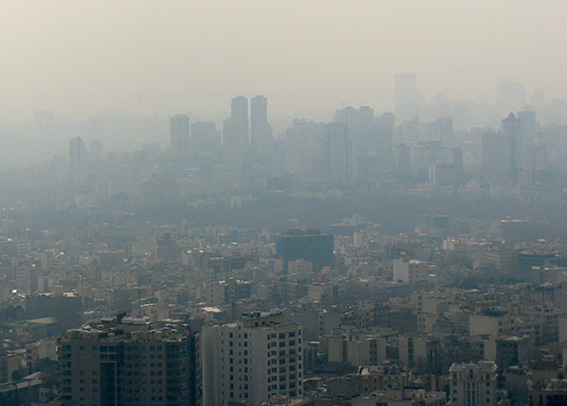It’s winter again in the Iranian capital and that means pollution is on the rise. This unfortunate situation levies a heavy toll on the citizens of the capital city, with many people having to resort to wearing masks to fend off the effects of the daily pollution. The situation this week has only exhausted Tehran’s citizens further with the familiar “inversion effect” – the situation of cold air trapping pollutants on ground level. Earlier this week IRNA reported the situation had gotten so bad that emergency vans, ambulances were on call in the city’s five major squares. The head of Tehran Emergency called on seniors, children and those suffering from heart and lung complications to avoid unnecessary trips outside. Schools also had to cancel their morning exercise sessions due to the heavy pollution. Last march, Tehran’s governor said there had been 147 days of substandard air in the previous year with that figure likely to be repeated this winter.
Each time this happens, the health effects to the citizens are terrible but what is the financial cost? And, with this annual problem not going away, what are the financial costs to the city of 12 plus million and how much are we losing due to the never ending pollution?
The US National Library of Medicine states that Tehran is among cities ranked high for severe fine particle air pollution globally, with more than a third of the year characterized by unhealthy air pollution levels. This is partly the result of topography, as the city is bound by the mountains to the north and east. However, heavy reliance on motor vehicles for transportation is also part of the problem. It is estimated that vehicular emissions represent from 70 to 85 percent of total particulate emissions in the region.
Considering vehicular emissions of sulfur dioxide and nitrogen oxides that contribute to secondary particulates as well as primary particulates, ambient fine particle concentrations are even more closely correlated with vehicle emissions. Furthermore, many of the motor vehicles in Tehran are more than 20 years old and many lack catalytic converters. A 2002 study by the Statistical Center for Iran says that pollutants such as SO2, NO2, HC, PM10 and CO are the major air pollutants in Tehran, about 80-85 percent of which is produced by mobile sources of pollution. Although this study dates back to over 12 years ago, the situation in 2014 is only marginally better.
Sanctions Bonus
If the situation on the ground wasn’t grave enough, sanctions over the past few years have also led to an indirect contribution to the increase in pollution. Back in 2008 onwards, western sanctions imposed on Iran’s petrochemicals and oil industries, worsened the situation for car owners and pedestrians alike due to the lack of quality gasoline on the market. The previous administration was forced to produce its own “lower quality” fuel just to keep the country afloat, thus increasing the level of pollutants in the country, including in Tehran, according to many experts.
Science vs. Economics
A joint study conducted by the Islamic Azad University, Tehran University and California State University in 2008, previously worked out the cost of pollution over a period of a year in the capital. It stated that the daily health damage costs of air pollution in the Tehran Metropolitan area per each unit increase of each pollutant was estimated at $16,224 for each unit of PM10 particles (those originating from ageing cars and bikes). It also stated that the cost per unit for Carbon Monoxide or CO reached $28,816. Other particles included in the study were NO2 (Nitrous Oxide) at over $1,927 per unit and $7,739 for Sulfur Dioxide.
According to the study, the total cost of the pollutants, if they are higher than the standard level of Japan, of which the cost is based on, in Tehran is about $663.7 million. The study underlined that the actual day to day figure through the Tehran winter would probably be higher than the announced figure.
Tehran’s Response
For its part, Tehran Municipality has attempted to negate the situation by introducing traffic restrictions on odd and even days for motorists, along with a congestion zone, however this doesn’t do much but to move the pollution away from the center. The city has also made efforts to rid the Bazaar area of nuisance motorcycles – which pollute more than most cars – announcing this month that only electric motorcycles will be allowed. This proposal, although well intentioned, is going to create issues of its own considering the high price of new electric bikes. The overall cost to the municipality and the government over the next few years to negate the impact of pollution is only going to increase as the situation worsens.


